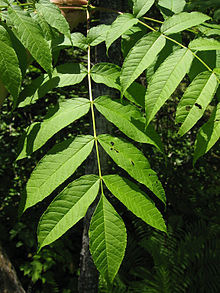Fraxinus nigra
| Fraxinus nigra | |
|---|---|
 |
|
| Scientific classification | |
| Kingdom: | Plantae |
| (unranked): | Angiosperms |
| (unranked): | Eudicots |
| (unranked): | Asterids |
| Order: | Lamiales |
| Family: | Oleaceae |
| Genus: | Fraxinus |
| Species: | F. nigra |
| Binomial name | |
|
Fraxinus nigra Marshall |
|
 |
|
| Natural range | |
Fraxinus nigra (black ash) is a species of ash native to much of eastern Canada and the northeastern United States, from western Newfoundland west to southeastern Manitoba, and south to Illinois and northern Virginia. Formerly abundant, as of 2014 the species is threatened with near total extirpation throughout its range, as a result of infestation by a parasitic insect known as the emerald ash borer.
Black ash is a medium-sized deciduous tree reaching 15–20 m (exceptionally 26 m) tall with a trunk up to 60 cm (24 inches) diameter, or exceptionally to 160 cm (63 inches). The bark is grey, thick and corky even on young trees, becoming scaly and fissured with age. The winter buds are dark brown to blackish, with a velvety texture. The leaves are opposite, pinnately compound, with 7–13 (most often 9) leaflets; each leaf is 20–45 cm (8–18 in) long, the leaflets 7–16 cm (2 3⁄4–6 1⁄4 in) long and 2.5–5 cm (1–2 in) broad, with a finely toothed margin. The leaflets are sessile, directly attached to the rachis without a petiolule. The flowers are produced in spring shortly before the new leaves, in loose panicles; they are inconspicuous with no petals, and are wind-pollinated. The fruit is a samara 2.5–4.5 cm (1–1 3⁄4 in) long comprising a single seed 2 cm (3⁄4 in) long with an elongated apical wing 1.5–2 cm (5⁄8–3⁄4 in) long and 6–8 mm (1⁄4–5⁄16 in) broad.
...
Wikipedia

